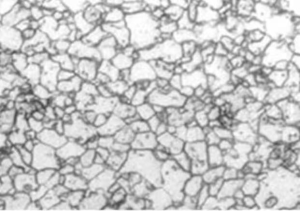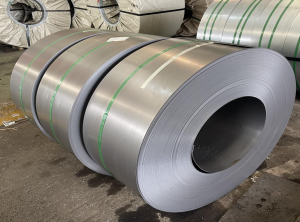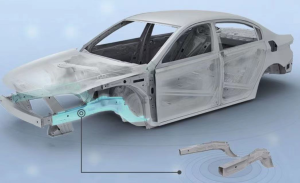CR260LA
What is High Strength Low Alloy Steel?
High-strength low-alloy (HSLA) steel is a steel with higher mechanical properties than conventional carbon steel. HSLA steels typically contain small amounts of carbon (0.05% to 0.25%) and small amounts of alloying elements such as manganese, nickel, cCRomium, molybdenum, vanadium, and copper, which contribute to their excellent mechanical properties.
The main advantage of HSLA steels is their high strength-to-weight ratio, making them a popular choice for many applications where weight reduction is critical, such as the automotive and aerospace industries. HSLA steel can also be easily formed and welded, making it ideal for a wide range of applications.
HSLA steel can be further divided into various grades based on their mechanical properties, which are generally defined by yield strength, tensile strength, and elongation.

Typical structure of high strength low alloy steel
Is CR260LA a high strength low alloy steel?
Yes, CR260LA is a High Strength Low Alloy (HSLA) steel. It is a cold rolled duplex HSLA steel with a minimum yield strength of 260 MPa (megapascals) and a minimum tensile strength of 340 MPa. CR260LA contains small amounts of carbon, manganese, silicon and other alloying elements such as niobium and titanium which contribute to its high strength and excellent formability. This type of steel is commonly used in automotive components, construction equipment and other structural applications that require high strength and good formability.
What is the chemical composition of CR260LA steel?
The chemical composition of CR260LA steel is usually as follows:
Carbon (C): 0.12%
Manganese (Mn): 1.00%
Phosphorus (P): 0.030%
Sulfur (S): 0.015%
Silicon (Si): 0.50%
CCRomium (Cr): 0.40%
Nickel (Ni): 0.50%
Copper (Cu): 0.10%
Vanadium (V): 0.10%
Titanium (Ti): 0.22%
Aluminum (Al): 0.015%
Nitrogen (N): 0.008%
These alloying elements contribute to the high strength and excellent formability of CR260LA steel. Low carbon content and dual-phase microstructure help to improve the weldability and toughness of steel, while the addition of elements such as cCRomium and nickel enhances the corrosion resistance of steel. The exact composition of CR260LA steel may vary slightly by manufacturer and intended application.
How about the mechanical properties of CR260LA?
The mechanical properties of CR260LA steel are generally as follows:
Yield Strength (min): 260 MPa (38 ksi)
Tensile Strength (min): 340 MPa (49 ksi)
Elongation (min): 34%
These mechanical properties are measured using standard test methods and may vary slightly depending on the specific manufacturing process and heat treatment of the steel. CR260LA steel has a high strength-to-weight ratio, good formability and improved fatigue resistance compared to conventional carbon steels. The steel’s dual-phase microstructure allows it to be easily formed into complex shapes without cracking or breaking, while the low carbon content and alloying elements help improve its weldability and toughness. These properties make CR260LA steel a popular choice in the automotive, construction and manufacturing industries where high strength and good formability are critical.
What are the characteristics of CR260LA steel?

CR260LA is a high strength low alloy (HSLA) steel with a duplex microstructure. Its features include:
High Strength: With a minimum yield strength of 260 MPa and a minimum tensile strength of 340 MPa, CR260LA is stronger than many conventional carbon steels.
Excellent formability: CR260LA has good formability due to its dual-phase microstructure, which consists of a soft ferrite phase and a hard martensite phase. This allows it to be easily formed into complex shapes without cracking or breaking.
Good weldability: CR260LA can be easily welded using conventional welding techniques, making it suitable for welding structures and components.
Improved fatigue resistance: CR260LA has improved fatigue resistance compared to conventional steel, meaning it can withstand repeated loading and unloading cycles without cracking or other forms of damage.
Corrosion resistance: CR260LA has good corrosion resistance because it contains alloy elements such as cCRomium and nickel.
Lower carbon footprint: CR260LA requires less energy to produce and emits fewer greenhouse gases than other high-strength steels, making it a more sustainable choice.
How is CR260LA steel manufactured?
Hot rolling: Steel is first heated to high temperatures and then passed tCRough a series of rolling mills to reduce its thickness and shape it into coils.
Annealing: The coil is then annealed in a furnace to soften and improve its formability. During annealing, steel is heated to a specific temperature and held for a period of time to allow it to recrystallize.
Cold rolling: the annealed coil is then cold rolled to further reduce the thickness and increase the strength.
Batch annealing: Cold rolled coils are subsequently batch annealed in a furnace to form a dual phase microstructure consisting of soft ferrite and hard martensite. The annealing process involves heating the coil to a specific temperature for a period of time to transform the steel into the desired microstructure.
Final machining: The final machining step consists of cutting the steel to the desired length and performing any necessary finishing operations such as trimming, slitting or coating.
The resulting CR260LA steel has a high strength-to-weight ratio, good formability and improved fatigue resistance, making it suitable for a wide range of applications in the automotive, construction and manufacturing industries.
What are the coating types of CR260LA steel?
CR260LA steel can be coated with various coatings depending on the intended application. Some common coating types for CR260LA steel include:
Electro-galvanized coating (EG)
Hot dip galvanized coating (GI)
Hot dip galvanized iron alloy coating (GA)
Hot-dip galvanized aluminum-magnesium alloy coating (ZM)
The choice of coating type depends on factors such as the intended application, the level of corrosion protection required, and the cost of the coating process. It is important to select a coating that is compatible with the properties of CR260LA steel to ensure proper coating adhesion and effective corrosion protection.
What are the applications of CR260LA steel in automobile manufacturing?

CR260LA steel is commonly used in automotive manufacturing due to its high strength-to-weight ratio, good formability, and improved fatigue resistance. Some common applications of CR260LA steel in automotive manufacturing include:
Body panels: Due to its high strength and excellent formability, CR260LA steel is commonly used in the manufacture of body panels such as hoods, doors, fenders, and roofs. The steel can be easily formed into complex shapes without cracking or breaking, and its high strength-to-weight ratio allows for lighter designs without sacrificing performance or safety.
Chassis components: CR260LA steel is also used to manufacture chassis components such as suspension components and steering components due to its high strength and toughness. The steel can withstand the stresses and strains of everyday driving without deforming or failing, and its high resistance to fatigue helps extend the life of components.
Safety components: CR260LA steel is commonly used in the manufacture of safety components such as seat frames and roll cages due to its high strength and impact resistance. Steel absorbs and dissipates energy during a crash, helping to protect occupants from injury.
Exhaust system: CR260LA steel can also be used in the manufacture of exhaust systems due to its high temperature and corrosion resistance. The steel can withstand the heat and moisture generated by the engine without degrading or corroding, ensuring long-term durability and performance.
Overall, CR260LA steel is a versatile material that can be used in a wide range of automotive manufacturing applications with high strength, good formability and excellent fatigue resistance.
Solucky Steel Trading Company, provides a range of automotive steel products to meet the needs of customers in the automotive industry. These products include common cold-rolled dual-phase steels, multi-phase steels, high-strength low-alloy (HSLA) steels, advanced high-strength steels (AHSS), and other specialty steel grades used in automotive manufacturing. We can also provide you with customized steel products and services to meet your specific requirements. If you are looking for a high-strength low-alloy steel grade, CR260LA will be a good choice for you. If you are interested, you can contact us as soon as possible connect!

